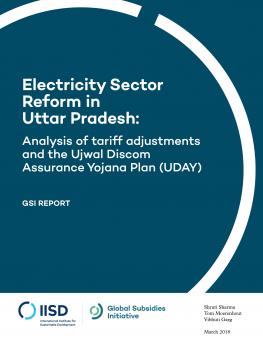
Electricity Sector Reform in Uttar Pradesh: Analysis of tariff adjustments and the Ujwal Discom Assurance Yojana Plan (UDAY)
This study by IISD-Global Subsidies Initiative (GSI) examines the electricity sector of the state of Uttar Pradesh by analyzing tariff adjustments and the financial assistance scheme UDAY.
Uttar Pradesh, India’s most populous state, is home to the country’s largest number of people without electricity access: as of late 2017, 14.6 million households—49 per cent of the state’s total—are yet to be electrified. Since 2015, however, the Government of India, in partnership with the state government, has been actively pursuing two targets: universal household electrification by 2019; and 24/7 power for all by 2022.
At present, the state’s public electricity distribution companies (discoms) are not financially sustainable—that is, they do not collect enough revenue from their consumers to recover their costs. The revenue gap has increased over the years resulting in a significant gap of INR 21,486 crores (USD 3.2 billion) in FY16.
Demands from a growing consumer base and the need to provide universal electrification conflict with the discoms’ inability to generate revenue from the same consumers. How then can discoms improve their financial viability in order to meet the state’s energy access needs?
One approach is to reform end-user tariffs, set by state-based market regulators on a cost-plus basis. Another approach is through a financial assistance scheme, Ujwal Discom Assurance Yojana (UDAY), launched in 2015.
This study investigates both tariff reform and the UDAY scheme. It uses a political economy approach to map stakeholders’ perceptions on tariff adjustments. The report carries out surveys and interviews with different consumer groups, a total of 1,917 households, 413 farmers, 65 commercial and industrial consumers. The interim assessment of UDAY was conducted by identifying Uttar Pradesh’s progress against various milestones specified in the scheme and 12 interviews with officials from discoms and the state government.
The report lists key findings on energy use, billing, perceptions and preferences with respect to tariff reform. It also lists progress made under UDAY and some of the key requests of discoms. The report makes recommendations and several points of guidance for governments to consider when planning tariff increases and achieving the milestones set under UDAY.
Additional downloads
You might also be interested in
Increased Support Needed to Achieve India's Clean Energy Goals
India is on track to achieve many of its 2030 clean energy goals but needs to step up government support measures to accelerate the deployment of offshore wind, electric vehicles, and green hydrogen, according to a new report.
India Faces Clean Energy Challenges as Energy Demand Soars and Global Fossil Fuel Subsidies Rise
New research finds the global energy crisis and increasing energy demand have pushed India's energy subsidies to a 9-year high.
G20 energy ministers call for cooperation on nuclear energy & low-emission hydrogen
The Group of 20 energy ministers' meeting concluded in Goa on July 22, 2023, with the final summary failing to include language on the phase-down of unabated fossil fuels.
Implementing Solar Irrigation Sustainably
This guidebook provides recommendations to state policy-makers on how they can implement solar irrigation models, particularly decentralized solar plants for irrigation under the PM-KUSUM scheme, effectively and sustainably.